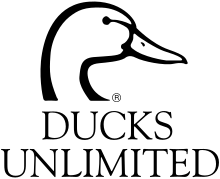Ducks Unlimited facts for kids
 |
|
| Founded | 1937 |
|---|---|
| Founder | Joseph Knapp |
| Type | Nonprofit organization |
| Focus | Waterfowl habitat conservation |
| Headquarters | Memphis, Tennessee, US |
|
Area served
|
North America |
|
Members
|
700,000 |
|
Key people
|
Chuck Smith, President Adam Putnam, CEO |
|
Volunteers
|
40,000 |
| Website | ducks.org |
Ducks Unlimited (DU) is a group in America that works to protect wetlands. Wetlands are like marshy areas, and they are super important homes for ducks, other birds, and many different animals. DU also helps protect the dry land around these wet areas. It is a nonprofit organization, which means it uses all its money to help its cause, not to make a profit for owners.
Contents
How Ducks Unlimited Started
In 1927, a group called the American Wild Fowlers was formed. They focused on managing birds for sport. Important people like Arthur Bartley and Nash Buckingham were part of this group.
Later, in 1930, a man named Joseph P. Knapp started a new organization. It was called More Game Birds in America. The American Wild Fowlers group soon joined this new effort. Joseph Knapp owned many popular magazines and books.
In 1937, Joseph Knapp and a few other people who cared about nature decided to do more. They saw that the number of ducks and other waterfowl was going down. They wanted to protect the places these birds lived, especially in Canada. So, on January 29, 1937, Ducks Unlimited was officially created. A local artist named Ernie Wilson designed the first Ducks Unlimited logo. The More Game Birds in America group then became part of Ducks Unlimited.
Ducks Unlimited Around the World
Ducks Unlimited Canada was started in Winnipeg, Manitoba, on March 10, 1937. By 2020, over 111,000 people were part of the conservation community in Canada.
Ducks Unlimited also works in Mexico through a partner group called Ducks Unlimited de Mexico. Other groups have also started in places like Latin America, New Zealand, and Australia.
Protecting Habitats
Ducks Unlimited has helped protect at least 15 million acres of land for waterfowl in North America. That's a huge amount of space! DU works with many different groups. These include companies, governments, other non-profit organizations, landowners, and regular people.
They work together to fix areas that have been damaged. They also try to stop more damage from happening to wetlands. DU also helps advise governments on policies that protect wetlands and the environment.
In 2019, Ducks Unlimited raised over $201 million. A lot of this money, at least 80 percent, goes straight to protecting habitats. They get money from government programs, donations, and members.
Most of DU's supporters and 90 percent of its members are hunters. Their magazine, DU Magazine, has many stories about waterfowl hunting. They also get money from ads for hunting gear. Sometimes, artists create duck artwork for DU to sell. A part of the money goes to the artist, and most goes to Ducks Unlimited. Eric Thorsen is one artist who has helped with fundraising.
In 2019, Ducks Unlimited Canada and the University of Saskatchewan started a special program. It's called the "Ducks Unlimited Canada Endowed Chair in Wetland and Waterfowl Conservation." This program helps university students and teachers learn more about wetlands and waterfowl. They also do research and share what they learn.
In March 2019, Adam Putnam became the new Chief Executive Officer of Ducks Unlimited. He used to be a government official in Florida.
Conservation Efforts
Ducks Unlimited used to focus most of its wetland protection projects in Canada. These projects were mainly in the prairie areas where ducks breed. Now, Ducks Unlimited Canada works in every Canadian province and territory.
Ducks Unlimited has also expanded its work to every state in the United States and in Mexico. They still focus on the most important places for waterfowl. This includes restoring duck breeding areas in Canada and the northern central states. They also protect places where ducks spend the winter, mostly in coastal and southern states and in Mexico.
Helping After Oil Spills
After the 2010 Deepwater Horizon oil spill in the Gulf of Mexico, Ducks Unlimited helped with many clean-up efforts. They worked with groups like the National Fish and Wildlife Foundation. They also partnered with the USDA Natural Resources Conservation Service. Together, they protected about 79,000 acres of land for waterfowl and other waterbirds.
In 2015, Ducks Unlimited worked with The Trust for Public Land. They built an online tool to track all the conservation and clean-up work after the oil spill. In 2018, the National Oceanic and Atmospheric Administration (NOAA) gave Ducks Unlimited $1.8 million. This money was to help clean up oil spills and dangerous waste in Texas. These spills came from the Gulf of Mexico.
Important Places for Conservation
Ducks Unlimited focuses on several key regions. These areas are very important for waterfowl and other wildlife.

- Prairie Pothole Region: This area has many small wetlands, like potholes, where ducks nest.
- Western Boreal Forest of Canada: A large forest region with many lakes and wetlands.
- Mississippi Alluvial Valley: A flat area along the Mississippi River, important for migrating birds.
- Central Valley and Coastal California: Key areas for birds that spend winter there.
- Gulf Coastal Prairie: Coastal areas along the Gulf of Mexico that are vital habitats.
Ducks Unlimited on TV
Ducks Unlimited has its own television show called Ducks Unlimited TV, or DUTV. The show is hosted by Field Hudnall, Wade Bourne, and Ainsley Beeman. It features stories about conservation and waterfowl hunting across the United States.
See also
- Al Agnew
- Mississippi Flyway
- Weed Lake

